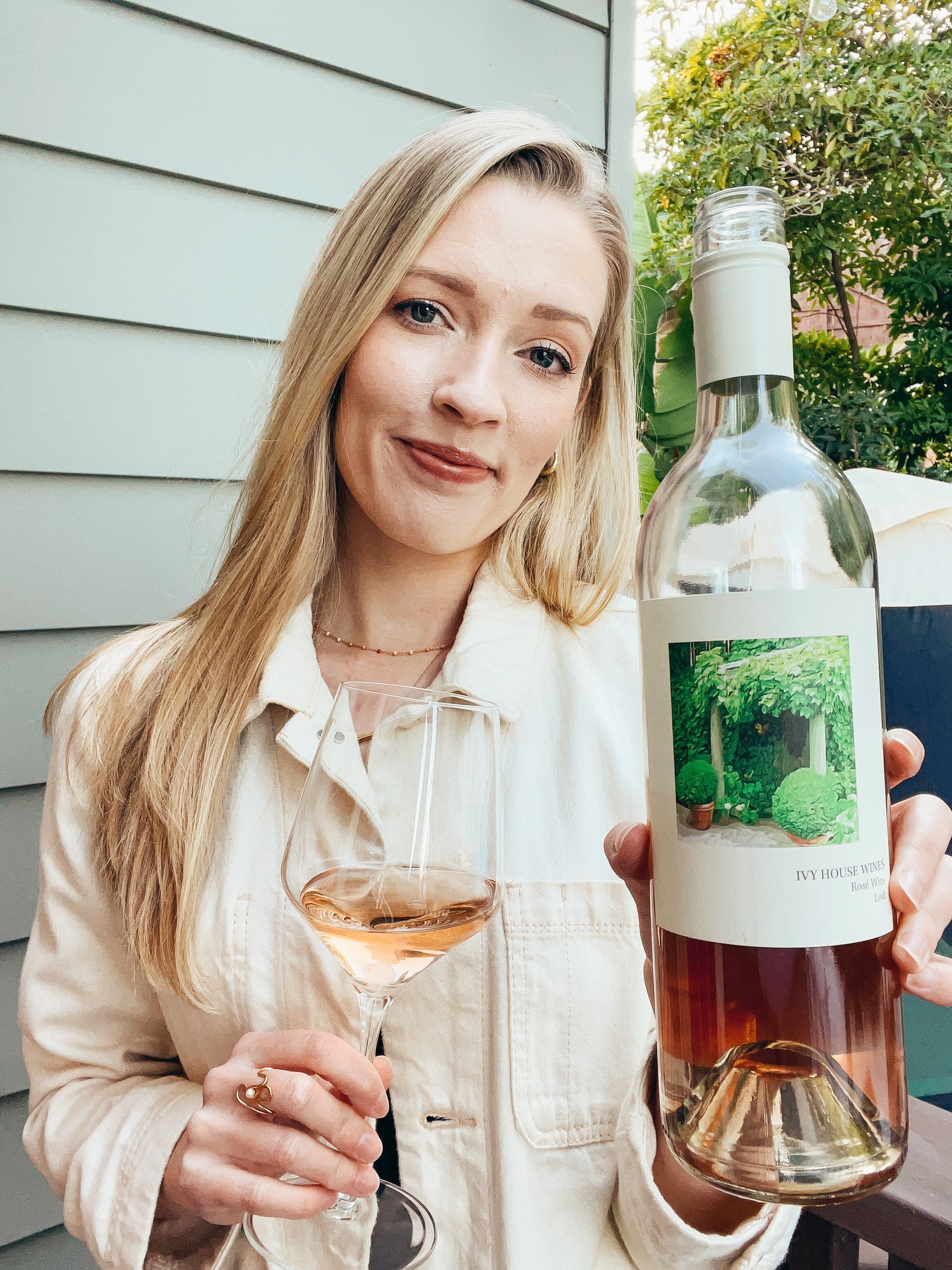What is Dry Wine? The Best Dry Wines to Drink During Dry January & Beyond
Are you participating in Dry January? Me too. But maybe not in the conventional sense.
I’ll be focusing on drinking dry wines this month in honor of Dry January, and I invite you to join me.
In this post, I’m breaking down what a dry wine really is, how to shop for dry wines, and how to identify a wine’s sweetness level, as well as some of the best dry wines that you can explore this month, or throughout the year. Some of these wines might actually surprise you…
What is Dry Wine? The Best Dry Wines to Drink During Dry January & Beyond
What is Dry January?
Dry January is the annual tradition of restricting alcohol from your diet for the entire month.
While this may not come as a shock to many of you, I’m not a big proponent of Dry January.
Why? Because I believe moderation is key and restricting anything from your diet will only lead to further binging of that item down the line. That’s just my opinion, and how I personally function.
However, I am all about starting the year on a fresh note, eating healthy, and watching my wine intake. Again, moderation is key.
As a wine professional, I try to take a very balanced approach to drinking wine, and it might interest you to know that some wines have more sugar content than others. So, rather than cutting out wine completely and removing one of the small joys in life for a full month, I invite you to explore some dry wines with me.
You might be surprised by some of the wines I’m sharing here, as you may have previously seen these wines as sweeter than other wines you’ve tasted. I’m going to teach you all about what dry wine really means, and some tricks to identifying wines that are dry v.s. wines that are sweet when you’re tasting.
If you’re interested in learning more about how to break down the structure of a wine, book a virtual wine tasting with me and I’ll teach you some tricks to help you learn more about your palate and find more wines you love.
The sweetness level of a wine is determined during the fermentation process. If the yeast eat all of the sugar in the grape must and convert it into alcohol, the wine will be dry. If the fermentation is stopped early, the wine will have some residual sugar and taste sweeter.
What is meant by dry wine?
Describing a wine as dry often gets mixed up with the drying sensation that is caused by tannins; however, a dry wine just means it is a wine that is not sweet.
When it comes to describing wine, dry is the opposite of sweet.
Dry wine = wine that is not sweet.
To understand this, we’ll need to do a quick recap on how alcoholic fermentation works.
When fermentation occurs, microorganisms, known as yeast, convert the sugar in the grapes into alcohol.
Sugar content and alcohol are inversely related in this process. As more sugar is eaten (and therefore removed from the fermenting wine), more alcohol is created.
So, if the yeast finish their jobs, so to speak, there will be little to no sugar left in the finished wine. If there is sugar left in the wine, this remaining sugar is known as “residual sugar”, or RS.
Doesn’t this mean any wine can be dry or sweet? Yes, that’s correct. Any wine can be made into a dry or sweet style, but chances are, most wines you’re exposed to as a consumer will be classified as dry.
Dry wines have lower residual sugar content than other wines that are not considered dry. For reference, to categorize a dry wine, the wine will need to have less than around 10 g/L of residual sugar.
Not to get too technical, but if the wine has 0 g/L of residual sugar, you can call this a bone dry wine. There are, of course, varying levels of dryness, but for the purpose of this post, we’ll be referring to dry wines as an overall category for any wines with less than 10 g/L of RS.
The vocabulary used to describe sugar content in wine ranges from bone dry (with the lowest residual sugar) to very sweet (with over 100 g/L of RS).
Here’s a helpful chart from Wine Folly, which breaks down the different sweetness levels in wine. For this blog post, we are focusing on wines that fall into the bone dry or dry categories.
How much sugar is in a glass of dry wine?
You might be thinking, those numbers make sense, but I’m not going to drink an entire liter of wine, so how much sugar is actually in my glass of dry wine?
With around 10 g/L of residual sugar, dry wines typically contain about 1-2 grams of sugar per glass. Less than you thought, right?
So let’s get into some tricks on how to identify these dry wines and shop for “lower sugar” wines.
Note: Be aware of marketing scams that are trying to sell you “low sugar” wines. Since most wines are already low in sugar, this is literally just a marketing ploy for people who don’t know this about wine.
But not you! You’re better than that now, and I’m just here to help guide you to become a smarter wine consumer.
So let’s get into how to taste and shop for dry wines.
How do you know if a wine is dry?
When you taste a wine, it is often hard to tell the difference between a wine that is dry, and a wine that is just very fruit-forward.
I often hear my clients during virtual wine tastings say they think sauvignon blanc and pinot grigio are too sweet for them. However, these wines would both typically be dry, meaning again, there is little to no residual sugar left in the bottle.
This might not be full-proof, but a trick I learned recently is to taste the wine while plugging your nose. If the wine then tastes dry (not sweet), then you can call it a dry wine that is very fruit-forward. If the wine still tastes sweet with your nose plugged, chances are there is some residual sugar in that wine.
You might even be able to feel the syrupy texture of residual sugar that may be present int he wine.
How do you shop for dry wines?
The truth is, most wines you purchase at your local wine store will be considered dry.
Remember when I said alcohol content and sugar levels are inversely related when it comes to wine?
Here’s a little trick to use that will tell you about the sweetness level of a wine before you even purchase the bottle: check the ABV (or alcohol) percentage on the label.
Wines that are higher in alcohol tend to be lower in sugar (think: 12% ABV and higher). Why? Because the yeast completed their jobs of turning the sugar into alcohol during the winemaking process.
Wines with 11% ABV or below typically will have more residual sugar. This is why some off-dry or sweet German rieslings have around 8-9% alcohol, or less.
Note: Be aware of wines with 17% ABV and above, as this will usually indicate a fortified wine, and it may not be dry because sugar has been added to the wine during the winemaking process. For example, Port typically has around 20% ABV, with about 100 g/L of residual sugar.
However, generally you’ll be able to use this ABV trick on the wines you’re perusing at the store.
You might be led to believe sauvignon blanc is a sweet wine because it is so fruity, however, sauvignon blanc is most often produced in a dry style. If you like fruit-forward sauvignon blancs, try some from California or New Zealand.
What types of wine are dry?
Well, most likely, many of the wines you’re regularly sipping on are dry. Some of the most common wines like chardonnay, sauvignon blanc, pinot noir, cabernet sauvignon, etc., are most often fermented to be dry.
If you’re shopping the bottom shelf (i.e. two-buck Chuck or other wines I wouldn’t recommend), these rules might not apply, as there is often some added sugar in these cheap wines.
The $10-20 per bottle range is a safer bet. And as always, try to support a local wine store or smaller, family-owned wineries, if you can. This will also help guarantee the absence of added sugar or other crazy additives that can be found in mass-produced wines.
So, low-sugar, dry wines? I got you. Here are some of the best dry wines to savor this Dry January (and throughout the rest of the year).
By the way, some of these might surprise you…
Note: As a general rule of thumb, you should know that New World wines are typically fruitier than Old World wines. This doesn’t necessarily mean they have more sugar, but if you’re going for a less fruity wine, Old World is a good place to start. Old World wines are from Europe, while New World wines are from anywhere outside of Europe.
Here are some of the best dry wines that might surprise you
Don’t forget that any wine can be made into a dry or sweet style. I’m just sharing some wines that are ultimately delicious and often surprise people that they are considered dry.
Here are some of the best dry wines that you might not have previously considered dry. Hopefully, this gives you a new perspective on what dry wine really means.
Notice this bottle of champagne states “Brut” on the label. Brut means the champagne has 0-12 g/L of residual sugar, and it will most likely taste like a dry wine.
Champagne
Champagne and other sparkling wines are the most upfront about how dry or sweet they are. When shopping for sparkling wine, look out for the below terms on the label to find out the wine’s sweetness level.
These are the indicators of sugar levels for champagne, listed from driest to sweetest, along with their residual sugar content:
Brut Nature/Brut Zero: 0-3 g/L
Extra Brut: 0-6 g/L
Brut: 0-12 g/L
Extra Dry: 12-17 g/L
Dry: 17-32 g/L
Demi-Sec: 32-50 g/L
Doux: 50+ g/L
As you can see, the terminology is a bit misleading here, but for a dry style of sparkling wine, you can select any wine through the brut level to have a dry-tasting, lower-sugar wine. Once you get to the extra dry category, the residual sugar is typically more noticeable on the palate.
Side note - if you’re interested in learning about how champagne is made, check out this blog post where I break down the traditional champagne method into six simplified steps.
Sauvignon Blanc
As mentioned, I’ve had a lot of clients during my virtual wine tastings tell me they don’t drink sauvignon blanc because it’s too sweet for them. This one is tricky.
While sauvignon blanc can be very fruit-forward, it’s most often produced as a dry wine.
If you enjoy the fruity, tropical flavors, go for sauvignon blanc from New Zealand or California. If you like more mineral-forward and floral notes, Sancerre or Bordeaux Blanc would be more your style.
Chardonnay
Ahh, chardonnay. The grape we all love to hate.
The truth is, chardonnay is a product of its environment. When winemaking techniques like malolactic fermentation or oak aging are used on chardonnay, it can become an offensive, buttery oak bomb, if not done well.
Chablis is one of my favorite dry styles of chardonnay. It’s high in acidity and mineral-forward, without the vanilla or buttery-richness you might find in mass-produced chardonnays.
If you enjoy this style, look for chardonnays that are “unoaked”. This might be indicated on the label. The absence of oak makes for a steely-mineral-forward wine with notes of citrus and green apples. This style is often used in making chardonnay from New Zealand.
If you like vanilla flavor, tropical fruit notes, and buttery texture (when done well), explore some California chardonnays, or of course, White Burgundy.
When we think of riesling, we might automatically assume the wine is sweet. However, any wine can be made into a sweet or dry style, and dry rieslings are some of the best dry wines.
Riesling
Wait what?? Dry riesling??
You heard it here first, folks. Riesling is one of my favorite dry wines.
That’s right, not all riesling is sweet. Remember that sweetness level is determined by how much sugar the yeast converted into alcohol during fermentation.
If the fermentation is stopped early, the wine will have residual sugar and some level of sweetness. If the fermentation is completed, the wine will be dry with a typical level of alcohol content for a dry wine (12-14.5%).
While sweet riesling is a popular style of wine, I encourage you to try some dry versions before coming to any conclusions about this grape.
Remember - check the ABV content on the label before you dive in. The lower alcohol levels in a riesling will indicate residual sugar (think: 8-9%). If the riesling has 12% ABV or higher, the wine is most likely dry.
Check out some dry rieslings from Germany. This might be indicated on the label as “Trocken”. Otherwise, use the ABV trick outlined above.
Other regions like the Finger Lakes of New York, Alsace in France, Austria, and Australia also produce some excellent dry rieslings.
Rosé
Rosé is another wine I commonly hear described as “too sweet”. Not only is this a sweeping statement, but it’s also incorrect for the most part.
While many of us are still tainted from the idea of sticky sweet White Zinfandel being a rosé, the most popular style of rosé these days is that of Provence, which is most often dry.
The best way to find out if a rosé is going to be dry or sweet is to do some research on the producer. Or if you stick to rosé from Provence, that’s a pretty safe bet that the wine will be dry.
Another thing to note is that the color of the rosé actually has nothing to do with the sweetness level of the wine. The color is just an indicator of how long the black grapes spent macerating with the juices.
You might be interested in reading more about how rosé is made in this blog post here.
Some cabernet sauvignon wines have jammy or ripe fruity flavors, which might lead you to believe this is a sweeter wine. However, cabernet sauvignon is most often made into a dry wine.
Cabernet Sauvignon
While often seen as a jammy or fruity wine, cabernet sauvignon is typically dry by definition.
If you like the blackberry pie filling or jammy notes, go for a California cabernet sauvignon, specifically one from Napa Valley or Paso Robles. This will still most likely be dry, but the fruity flavors might mask the fact that there is little to no residual sugar in the wine. For a truly elevated experience, visit Azur Wines tasting lounge in downtown Napa, where you can savor their celebrated Napa Cabernet Sauvignon while exploring the area’s vibrant wine, food, and boutique scene
If you like more green notes and spice, try a Chilean or French cabernet sauvignon.
Merlot
Like cabernet sauvignon, because of its fruity flavors, merlot might mistakenly not be seen as a dry wine. However, it most often is.
With New World merlot, the notes of chocolate and ripe fruits might make you lean towards thinking this is an off-dry wine, but merlot is more likely than not made into a dry wine.
If you like the concentrated fruit flavors, try New World merlots from California or Australia. And if you are looking for more spice or herby notes in your merlot, stick to Right Bank Bordeaux or South America.
I hope I’ve inspired you to explore some dry wines and taste with a new perspective. Remember, most wines do not have as much sugar as you might think, but moderation is always key.
If you’d like to learn more about how to better identify sweetness levels in wine, book a wine tasting with me and I’ll teach you some techniques to break down the structure of wine and learn your personal preferences.
Find any dry wines you’ve enjoyed lately? Share them below! I’d love to hear your thoughts.
In the meantime, check out this blog post about some of my favorite red wine and cheese pairings.
Ready to further your wine education? Enroll in a WSET class today and use code LexiStephens for a discount.











